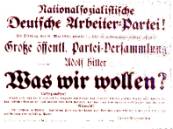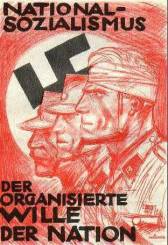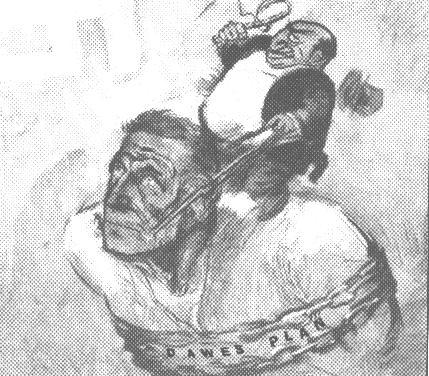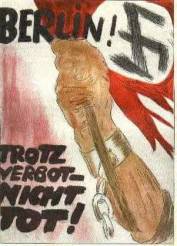|
|
|
||||||||||||||||||||||||||||||||||||||||||||||||||||||||||||||||||||||||||||||||||||||||||
|
The Nazis grew out of a small right-wing party, which Hitler took over after 1919. He developed a Twenty-Five Point Programme based on hatred, and built up a paramilitary group (the SA) to defend his meetings and attack other parties. The Nazis appealed to a wide range of people, but especially the 'middling' sort of people, and the party grew rapidly in the years of crisis 1919-1923. After the disaster of the Munich Putsch, and during the prosperity of the Stresemann years, however, support for the Nazis fell. During this time Hitler believed that he could be elected to power. He used these years to develop and strengthen the party's organisation.
|
Going DeeperThe following links will help you widen your knowledge: BBC Bitesize on Nazi beliefs & structure and development of the Nazi Party 1924-29 Good notes The History Place is fantastic - especially on the Formation and the 'Quiet Years' Who voted Nazi? - difficult article by Dick Geary
YouTube Nazi Germany: Rise to Power - excellent History File video.
|
||||||||||||||||||||||||||||||||||||||||||||||||||||||||||||||||||||||||||||||||||||||||||
Formation of the Nazi Party and its Beliefs and Organisation
1. StartThe German Workers’ Party, led by Anton Drexler, was formed in 1919. Hitler joined and soon became leader. His speeches gave people scapegoats to blame for Germany’s problems:
At first, the Party aimed to take power by armed force, building up a strong paramilitary force, the Sturmabteilung ('Stormtroopers').
2. Twenty-five Point ProgrammeIn 1920, the party renamed itself the National Socialist German Workers’ Party (Nazis), and announced its Twenty-Five Point Programme. At first, the Nazis were both nationalist (they believed in Germany’s greatness) and socialist (they believed the state should benefit everybody equally).
3. Mein KampfAfter the failure of the Munich Putsch in 1923, Hitler was sent to Landsberg jail. There he wrote Mein Kampf (My Struggle) advocating:
Hitler decided that he would have to get power by being elected, rather than by rebellion. However, he was banned from speaking until 1928.
4. Bamberg Conference, 1926At first, there were a number of people involved in running the party. Perhaps most important was Gregor Strasser, whom Hitler had appointed to grow the Party in the north of Germany – Strasser dramatically increased the number of Nazi cells in the north from 71 in 1923 to 262 in 1926. Under Strasser and Josef Goebells, the northern Nazis formed a 'Working Association' which met twice (in Nov 1925 and Jan 1926) to reshape the Party – they wanted:
Hitler saw these developments as a threat. He called a Conference in Bamberg, and gave a long speech in which he rejected all these ideas, and insisted instead on the Führerprinzip – the 'Fuhrer principle': his complete control over every aspect of the Party policy and organisation.
Source C
This table shows the percentage of each social group in the Nazi Party, compared to the size of that group in the country as a whole. Which groups did the Nazis appeal to most?
|
Source A
This Nazi poster, 11 May 1920, advertises a speech by Hitler: "What Do We Want?" It reads: "Do not believe that other parties can save the Germany of misfortune and misery, the nation of profiteers and debt, the land of Jewish corruption!"
Source BIn the future we may be faced with problems which can be solved only by a superior race of human beings, a race destined to become master of all the other peoples and which will have at its disposal the resources of the whole world. Hitler, Mein Kampf (1924)
Source C
This poster reads: "National Socialism: the organized will of the nation".
Source D
An election poster published by the Nazi Party in 1924.
| ||||||||||||||||||||||||||||||||||||||||||||||||||||||||||||||||||||||||||||||||||||||||||
Decline of the Nazi Party, 1924-9
1. Elections and declineAt first, the Party struggled to succeed at the ballot box, particularly as Hitler was banned from speaking. The prosperity of the Stresemann years, particularly, meant that the Nazis' message became less appealing and the party lost support.
|
Source ESupport for the Nazi Party had grown due to the country's problems of hyperinflation and the French invasion of the Ruhr. By 1928 Nazism appeared to be a dying cause. Now that Germany's outlook was suddenly bright, the Nazi Party was rapidly withering away. One scarcely heard of Hitler or the Nazis except as a joke. William Shirer,
The Rise and Fall of the Third Reich (1959)
| ||||||||||||||||||||||||||||||||||||||||||||||||||||||||||||||||||||||||||||||||||||||||||
|
The Number of Seats in the Reichstag held by each Party, 1919-33
Copy-&-paste the figures from the table above into an Excel workbook and select 'Insert ' to draw a line graph of party electoral fortunes. Then write a paragraph in words to explain what the graph shows.
|
|||||||||||||||||||||||||||||||||||||||||||||||||||||||||||||||||||||||||||||||||||||||||||
2. Re-organising the PartyIn this period, however, Hitler set about reorganising the Party. He put in place many of the things which helped it take power after 1928:
Consider:1. Explain the symbolism, meaning and appeal of the Nazi poster in Source D. 2. Looking at all the information on this page, list the key strengths of the Nazi Party. 3. Do you agree wth Source E? How strong do you think the Nazi Party was in 1929?
|
Source FThe Weimar government brought inflation under control and the economy began to improve. Because of this, the German people started to believe in the democratic system and were not interested in Hitler’s ideas. Hitler claimed he was no longer trying to start a revolution and said he was willing to compete with other political parties in democratic elections. However, this policy of taking part in elections was unsuccessful. The Nazi Party won 14 seats in the December 1924 election. In the 1928 election they only won 12 seats; less than 3% of the people voted for the Nazi Party. From Spartacus Education, a history website.
Source G
This Nazi poster c.1927 reads: "Despite the Ban, not dead." This poster was drawn by 'Mjölnir' (real name was Hans Schweitzer) who set new standards for Nazi publicity.
|
||||||||||||||||||||||||||||||||||||||||||||||||||||||||||||||||||||||||||||||||||||||||||
|
|
|||||||||||||||||||||||||||||||||||||||||||||||||||||||||||||||||||||||||||||||||||||||||||
|
Spotted an error on this page? Broken link? Anything missing? Let me know. |
| ||||||||||||||||||||||||||||||||||||||||||||||||||||||||||||||||||||||||||||||||||||||||||



